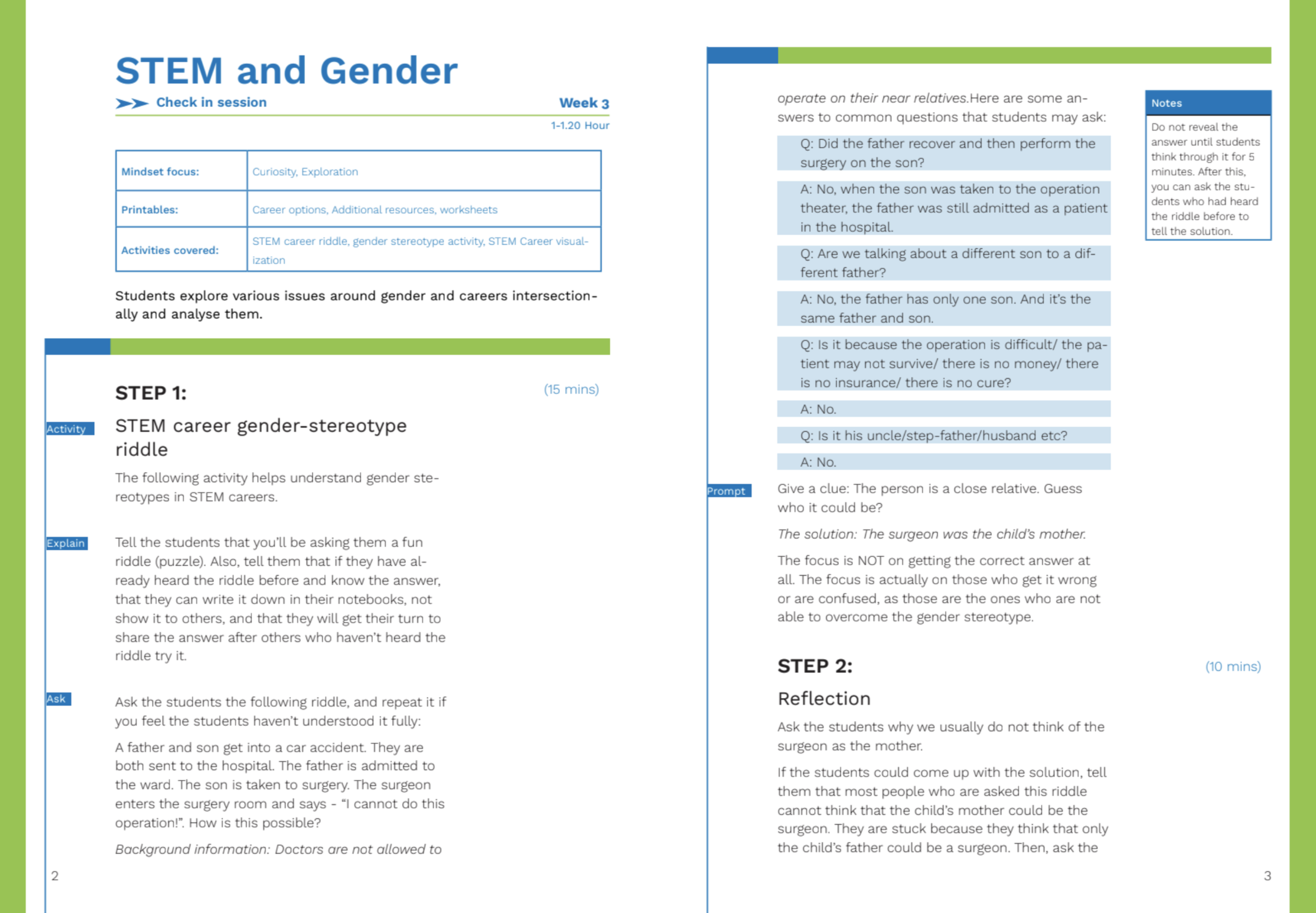
STEM for Girls
In partnership with Quest Alliance and with funding from IBM, we work with 800+ government schools in rural and underserved communities, and have designed a STEM club curriculum which interweaves STEM learning with questioning gender stereotypes. We also conduct capacity building of teachers in the schools to facilitate our educational interventions. Additionally, we conduct regular STEM hackathons in the schools.
Intersectional STEM curriculum
We’ve created an intersectional STEM curriculum for STEM clubs in the 800+ government schools we work with, which takes into account the unique cultural contexts of the students, and weaves activity-based STEM learning with questioning gender stereotypes and reworking gender-norms among students. The curriculum is for a year-long STEM club program, and is implemented through 3 activity-based guides we’ve written - the teacher’s handbook, the facilitator’s handbook, and the student’s handbook. Care is taken to use the simplest possible English in the material, and translations to various other Indian languages are in the works. We have also built in degrees of freedom within the curriculum, so that students from vastly diverse backgrounds can adapt the curriculum and guides to their own cultural contexts. Below are a few examples of this from the teacher’s handbook.
Green-practices snakes and ladders game - students design a snakes and ladders board game, with the snakes being the environmentally harmful practices, and the ladders being the environmentally beneficial practices, all within the unique contexts of their own cultures and localities. To figure out what the eco-friendly and eco-unfriendly practices in their vicinity are, the students interview people in their village. At the end of the activity, the students enjoy the game of green-practices snakes and ladders on the board they’ve themselves created. These boards from various different parts of India serve as interesting windows into the various unique practices in the vastly diverse parts of India.
Questioning superstitions - students learn about the Ouija board (a board used to speak to ghosts) which became popular in the US in the late 19th century. They then try speaking to ghosts with funny question prompts, first without a blindfold on, and then with a blindfold on. The aim is for them to discover that while coherent answers are provided by the so-called ghost when the students don’t wear blindfolds, the answers are all random when they have blindfolds on. The session concludes with them learning about the ideomotor effect and finally reflecting on what superstitions they can question in their unique cultural contexts.
Gender riddle - students are asked a riddle that has been shown to expose gender-stereotypes. The students then reflect on how those stereotypes are artificially reinforced, and instances in which they are skirted or broken, in their own unique cultural contexts.
STEM Hackathons
In the STEM hackathons, the girls choose what they want to build, have great fun building, gain confidence in their ability to build, and in the process, questioning any self-directed gender stereotypes, by building their own capacities and confidence to work in STEM.
Our hackathon outcomes can be classified into three categories - tech-oriented, semi-tech-oriented, and low-tech. Kids are not pushed to choose to build things using a microcontroller (tech-oriented) or even a wire (semi-tech-oriented) if they don’t want to - they can still learn a lot and have great fun by engaging in low-tech builds like making brooms from scratch by collecting large amounts of dried grass from around them, cutting them carefully, brushing them, and typing them up in just the right way. This lack of undue pressure creates a safe space where the kids can freely explore STEM and experience the joy of building, while putting themselves out of their comfort zone and feeling empowered in the process.
A tech-oriented build - Ashwini, Layanvi, Tejaswini, Bindu and Komala from Kolar, used ultrasonic sensors to build a prototype of a device that can help farmers detect and record data about animal or human trespassers in their farm, and also to differentiate between terrestrial animals and birds, so that the farmer can take action appropriate to the situation, without spending hours personally monitoring their crops.
Semi-tech-oriented - Kusuma, Ashwini, Rekha, Aishwarya and Vidya from Haveri created a floating lever switch which can be placed in a water tank - the switch goes on when the water level is high, and off when it goes low. When the switch is on, it turns on an LED, which turns off when the water level is low. This can serve as a light-alarm for when an overhead water tank is full, so that the pump can be turned off. The girls wanted to use a buzzer instead of an LED, but there was no buzzer readily available. No microcontroller was used here. All that was used were wires, a battery, an LED bulb, a longish twig and some thermocole.
Low-tech build - a team of girls from Chitradurga iterated on a design for a broom, and ended up making functional brooms from scratch - they collected the right kind of dried grass from the fields around them, brushed the strands smooth, cut them to just the right size, tied just the right amount of them together in a bunch with rope, built functioning brooms, and had great fun in the process.




